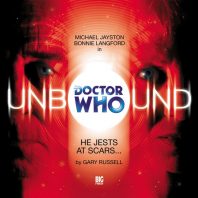
Released August 2003
With the Unbound series, the inevitable question was always going to be whether an individual story would choose to focus more on a continuity aspect, such as the Doctor never leaving Gallifrey as in ‘Auld Morality,’ or more on characterisation, such as with the morally devoid Doctor in ‘Full Fathom Five.’ Gary Russell’s ‘He Jests at Scars…’ goes down the former path, posing the intriguing backdrop of the Valeyard having won, in the process proving just why it is so vitally important that the Doctor should always emerge victorious.
In this reality, the Doctor never escaped the Matrix as he returned to save his archenemy, and the Valeyard has accordingly become a sort of composite being who- using the Matrix- has absorbed all of the Sixth Doctor’s future incarnations’ memories. Unfortunately, while he boasts of his superior mind, he inexplicably cannot foresee that his continued meddling with the timelines to undo his own past actions will have disastrous consequences for his own existence and the sanctity of the universe; though visuals like using the weapon from ‘Colony in Space’ to blow up Gallifrey or inadvertently killing his fourth self and thus preventing the emergence of his fifth are fascinating in their own right, the Valeyard acts with a profound haughtiness while putting into motion overly complicated plans that typify the most egregious villainous stereotypes with little other development as he goes to more and more desperate lengths to save himself from himself. Given that the darker Doctor storyline has just been brought to life so effectively in the previous tale, the overreliance on continuity references and flat development with no exploration of just why the Vaelyard is evil is a significant step backwards despite Michael Jayston given a beguiling performance that makes the most of what is given him.
While the Time Lords are not always portrayed as exactly the most competent omnipotent beings, the fact that they here need Mel to explicitly state to them that the Valeyard changing history is going to end in disaster goes against their very principles and paints them in an incredibly inept light, especially since they refuse to act until reality itself is threatened under the guise that the Valeyard is surely not that much different from the Doctor. Of course, the Valeyard killing his previous selves when they disagreed with him as he tried to get them to change their ways to align with his own speaks to just how ridiculous this villain as a microcosm of his entire race is in this particular universe. As Mel actively hunts the down the Doctor and promises to murder him if she doesn’t like his explanation, even the usual steadfast beacon of morality and common sense utterly falters, and having the script poke fun at those core characteristics of Mel is almost insulting to the character and to Big Finish as a whole given all the work that has gone into developing her into a more realistic and well-rounded presence in the audio medium’s early years.
Viewed as a comedy in which the Valeyard’s ever more complex plans continue to backfire on him makes ‘He Jests at Scars…’ a far more understandable story, but it’s clear that this is very much meant to be a serious look into what the Valeyard would do if given free reign. Unfortunately, the script features such an incredible reliance on both necessary and completely superfluous continuity that it’s all but inaccessible for a casual Doctor Who fan to fully grasp, the decision to use a secondary character from Big Finish’s own Sarah Jane Smith range as the Valeyard’s companion aptly summing up that notion as a whole. While Michael Jayston and Bonnie Langford do remain as committed to their roles and as enthralling as ever, and though the sound design is actually quite eerily brilliant, the plot material sadly veers into nonsensical territory far too often for the positive aspects of other components to ever redeem it, homaging a television era criticised for overindulgence in continuity and violence all too perfectly for all the wrong reasons.
- Release Date: 8/2003


Leave a Reply